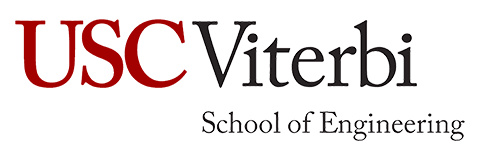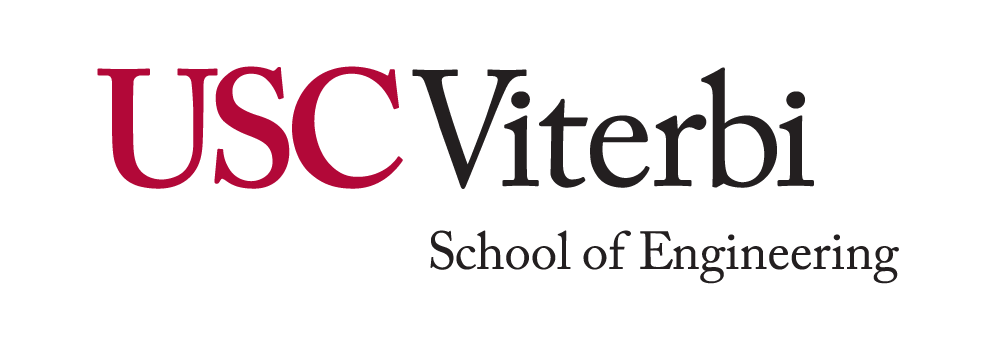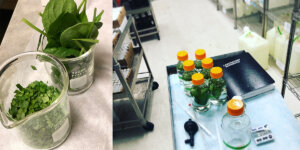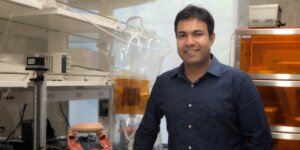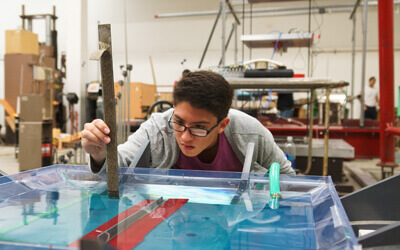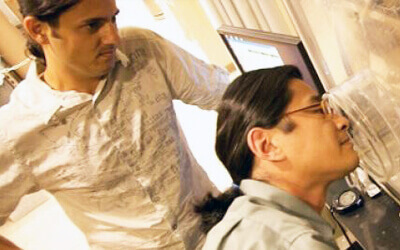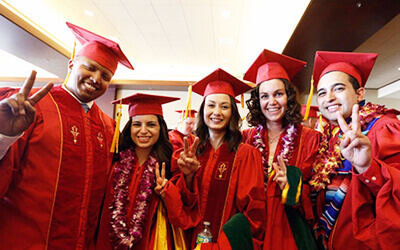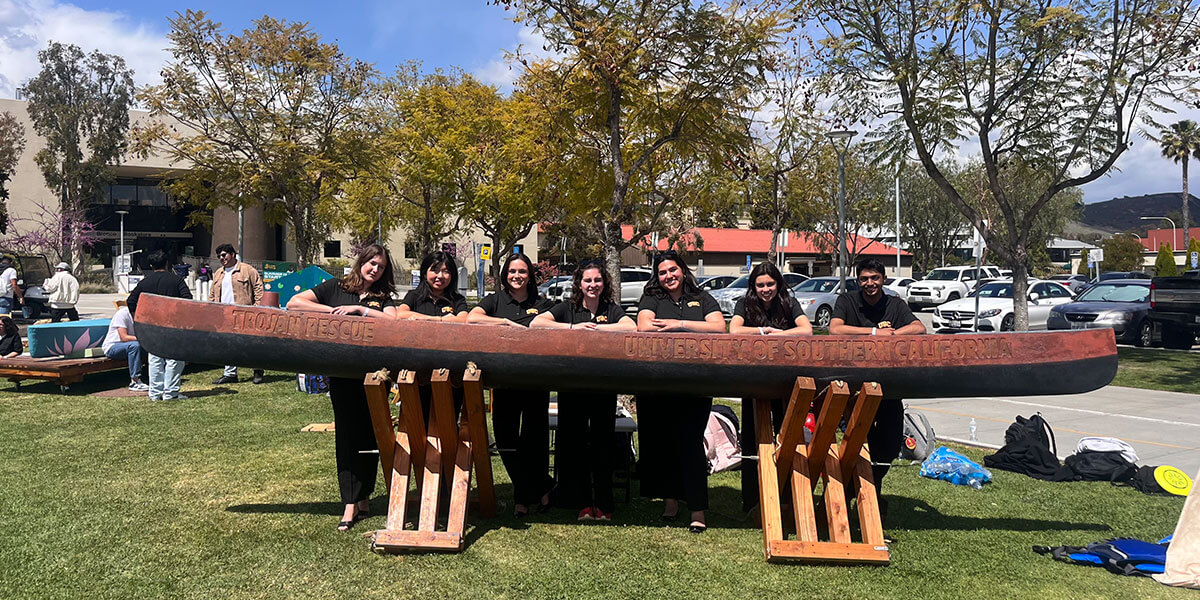
The USC Concrete Canoe team at the annual American Society of Civil Engineers (ASCE) concrete canoe competition
Reinforced concrete might not be the first material you’d choose when designing and building a canoe. However, that’s the challenge the USC Concrete Canoe Design Team set themselves each year when they create a new canoe from scratch, to race in the annual American Society of Civil Engineers (ASCE) concrete canoe competition.
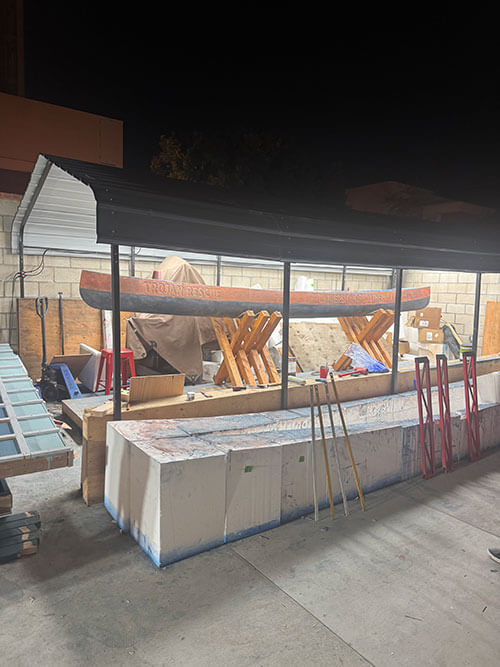
The concrete canoe during the fabrication process
In collaboration with Will Rollins, manager of the Baum Family Maker Space, the team have advanced their approach to digital design, project prototyping, and full-scale production, including the development of custom fabrication tools. By using Rhino 3D software, the team was able to reduce design and testing time from weeks to seconds. In addition, experimenting with using a CNC hot wire cutter significantly increased mold accuracy, while the development of larger aggregates improved the strength of the concrete to nearly 2900 PSI.
We caught up with Annicka Caprariello, the team’s captain, and Sherman Yan, advanced fabrication assistant at the Baum Family Maker Space, to discover the key components to designing and building a successful concrete canoe. Success doesn’t only amount to staying above water – in the case of the USC Concrete Canoe Design Team, it means consistently ranking among the top 10 competing teams from schools across the nation.
Accuracy
A custom CNC hot wire cutter
A major leap in precision came through the team’s decision to build a custom CNC hot wire cutter. This tool allowed them to skip the traditional hand-shaping of foam molds and instead move straight from digital model to physical form.
“We designed and built our own four-axis CNC hot wire cutter to cut out the foam molds,” said Yan. “That reduces a lot of imperfections in the mold, increasing the accuracy significantly.”
While some competitors from other schools also use CNC methods, the team’s use of hot wire cutting instead of a traditional end mill gave them greater control over detail and surface quality.
Iteration
Rapid design evolution
Switching from Fusion 360 to Rhino 3D with Grasshopper scripting allowed for faster, more flexible iterations. By automating the generation of code from curve-based inputs, the team drastically reduced turnaround time between design changes.
“Before using digital software, you’d have to redesign from scratch if you reached an impasse – but now we can input three curves and have the mold files ready in 30 seconds,” Yan explained. “We also built in analysis tools — checking if the canoe floats, calculating weight, and adjusting the rocker — all inside the script.”
This made it possible to rapidly test multiple versions, 3D print scale models, and even prototype a three-foot concrete canoe for small-scale testing before committing to the final design. This efficient feedback loop played a critical role in de-risking the full-scale build.
Strength
Testing new concrete mixes
The team also saw a major improvement in material performance, increasing the concrete’s compressive strength from 1500 PSI to nearly 2900 PSI.
“We were able to do that mostly by changing our aggregate size,” said Caprariello. “Concrete in buildings is around 3000 to 6000 PSI. We tested different mixes each month, using the compression machines in CEE’s Structures and Materials Research Laboratory.
Experimenting with larger aggregate sizes (3–5 mm instead of <2 mm) led to a more durable mix without sacrificing workability for the mold.
Shape
Streamlining for speed
The team intentionally moved away from flat-bottomed designs common in past years, opting for a longer, narrower canoe with a more pronounced rocker, suited for speed and racing performance.
“We’re going for more of a racing canoe style — rounder, more pointed, and longer,” said Caprariello.
This bolder shape was made feasible by the new modeling tools and CNC capabilities, allowing the team to test and tweak the curves until they reached the ideal balance of speed and stability. Small-scale testing helped verify that the canoe would perform as intended.
Collaboration
Sharing knowledge across disciplines
This year’s project was notable for how many contributors were involved across departments and teams. Key collaborators included Will Rollins and technical assistants at the Baum Family Maker Space, alumni mentors, CEE faculty members, and the AeroDesign Team (who provided insights into foam cutting).
“We were very much just student-led in the past,” said Caprariello. “But this year, having help from so many different specialists really made a difference.”
That support extended to equipment access, precise testing, and fabrication expertise, enabling the team to take on a more complex and technically ambitious project than in previous years.
—
With a more accurate build, a stronger structure, and a streamlined shape — all enabled by rapid iteration and broad collaboration — the design and build of the canoe represents an optimal approach to developing hands-on skills in engineering and problem solving.
Published on May 7th, 2025
Last updated on May 12th, 2025
